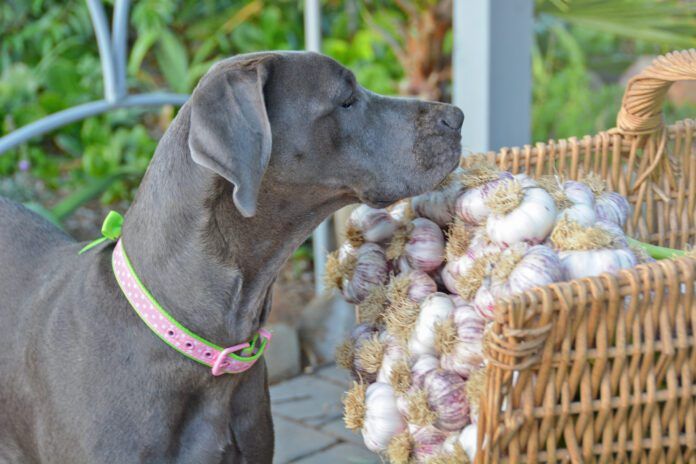Many human foods are toxic to dogs, including grapes, raisins, onions, and garlic. But, you say, garlic has health benefits for your dog and you like natural alternatives. That’s great! So do we! However, research shows garlic can damage your dog’s red blood cells when fed in inappropriate amounts. So, is it OK to feed garlic to dogs?
“Garlic is a tricky one because when used topically and sprinkled over food, it is great for dogs,” says CJ Puotinen, a long-time Whole Dog Journal contributor and author of books on holistic pet care. “It fights ear infections, internal infections, boosts immune systems, and lowers blood sugar. But it also contains thiosulphate.” That’s the concern: Thiosulphate can damage red blood cells in dogs.
How Much Garlic Can Your Dog Eat?
Many holistic veterinarians believe that feeding doses small amounts of garlic are not likely to pose problems for dogs. Be aware of iffy dosage recommendations: While a snippet of garlic may be OK for your dog, garlic powder is concentrated and dangerous for your dog.
The Pet Poison Helpline says symptoms of garlic poisoning include:
- Anemia
- Lethargy
- Pale gums
- Increased heart rate
- Increased respiratory rate
- Weakness
- Exercise intolerance
- Gastric upset
Why Feed Garlic to Dogs at All?
The purported benefits of feeding garlic to dogs may give you pause. For example, garlic is believed to combat high cholesterol in dogs. Maybe. But, if your dog is diagnosed with high cholesterol, you need to look at his diet. He’s probably eating too much fat. And a study from 2015 found garlic and onions can modify cancer risk.
Feeding garlic is highly dose dependent. “When used topically for wounds or ear infections, it’s harmless,” says Puotinen. When your dog eats it, that’s different. Puotinen writes that many veterinarians who prescribe garlic for dogs with fleas recommend 1/2 clove of fresh raw crushed garlic per 15 to 20 pounds of body weight. Again, safe in moderation.
Garlic for Warding Off Fleas
When introducing garlic to your dog, start with smaller amounts and increase gradually. Garlic doesn’t kill fleas, so adding it to your dog’s diet won’t make an immediate difference, but after a month of daily garlic, your dog should be far less attractive to fleas.
Of course, natural remedies like garlic for fleas are known to be limited in their effectiveness. If your dog is at a low risk of contracting fleas, it might help (check that dosage with your veterinarian, first, however). But, if you live where flea populations are high, you may want to consider a monthly preventative to kill fleas who jump on your dog and ward off flea infestations, which are notoriously difficult to eradicate.
A Toxic Reaction Is an Emergency
If your dog ever gets into something, garlic or anything else, and you are worried about toxicity, don’t take a chance. Call a pet-poison hotline for direction (there may be a charge):
ASPCA Animal Poison Control: 888-426-4435
Pet Poison Helpline: 855-764-7661







So I have been giving my dogs a small tablet of garlic and brewers yeast powder for fleas for many years with no issue. Lots of people do. What is your opinion on this?
I’m just a dog owner, but every holistic vet I’ve used has recommended it. One dog cannot tolerate brewers yeast–makes him very itchy.
Also “just” a dog owner and also a pet sitter. I used a garlic/brewers yeast supp along with a bath every 2-4 weeks, plus a “monthly” treatment for my dog. We had a week link, a cat we were trying to convert to an indoor cat, that kept the flea population going. About a month after adding that supp, I stopped seeing any fleas on my dog, so it definitely helped. I get the controversy though, so I don’t like to recommend it to others, unless a client specifically asks me about it. I refer them to their vets.
Also, feeding raw garlic v. feeding a prepared supplement requires more finesse.
Akitas and some other Japanese breeds (don’t remember which, read a scientific journal article many years ago) are particularly prone to anemia from garlic and shouldn’t be given it.
Garlic is fantastic! Over the past 20 years, the years my dogs were fed food-based supplements containing garlic and herbs for flea and tick prevention we had NO fleas. The two years I slacked off–holy cow. Right now, even though flea season is mostly over, I’m using garlic (oral) to help combat yeast-overgrowth in an ear and build immunity for his reoccuring lip pyoderma.
Dose: 1 medium-large (not jumbo!) clove, fresh, minced mixed into his food, twice a day. He weighs 60#.